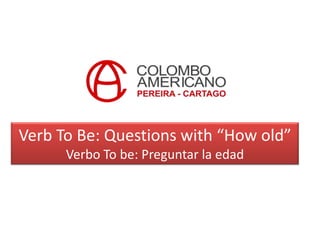Course 2-Unit 4: Verb to be - questions with how old
•
2 j'aime•9,834 vues
Signaler
Partager
Signaler
Partager

Recommandé
Recommandé
Contenu connexe
Tendances
Tendances (20)
adjetivos , adverbios , comparativos y superlativos.

adjetivos , adverbios , comparativos y superlativos.
En vedette
En vedette (20)
Use of Apps to Engage Students in Collaborative Writing, Great Plains Composi...

Use of Apps to Engage Students in Collaborative Writing, Great Plains Composi...
2009top10smallbusinesstrends 090528112514 Phpapp02

2009top10smallbusinesstrends 090528112514 Phpapp02
Course 9-Unit 4: Direct object placement with phrasal verbs.

Course 9-Unit 4: Direct object placement with phrasal verbs.
Responses to Doug Belshaw's LRA Presentation on Web Literaices

Responses to Doug Belshaw's LRA Presentation on Web Literaices
Course 2-Unit 5: Verb to be - prepositions in, at and on

Course 2-Unit 5: Verb to be - prepositions in, at and on
Creating Digital Exhibits for Critical Inquiry of Media Representations

Creating Digital Exhibits for Critical Inquiry of Media Representations
Course 8-Unit 2: The use of would rather + base form of verb.

Course 8-Unit 2: The use of would rather + base form of verb.
Plus de Martin Caicedo
Plus de Martin Caicedo (20)
Course 12-Unit 2: Perfect modals meaning and form. check for must, will be ab...

Course 12-Unit 2: Perfect modals meaning and form. check for must, will be ab...
Course 10-Unit 7: Gerunds as objects of prepositions.pending for review

Course 10-Unit 7: Gerunds as objects of prepositions.pending for review
Course 9-Unit 6: To make an offer or a suggestions with why don't ...

Course 9-Unit 6: To make an offer or a suggestions with why don't ...
Course 9-Unit 5: Quantifiers for indefinite quantities and amounts.

Course 9-Unit 5: Quantifiers for indefinite quantities and amounts.
Course 8-Unit 3: Perfect modals meaning and form. adjust.

Course 8-Unit 3: Perfect modals meaning and form. adjust.
Course 9-Unit 6: To make an offer or a suggestions with why don't.

Course 9-Unit 6: To make an offer or a suggestions with why don't.
Course 9-Unit 5: Quantifiers for indefinite quantities and amounts.

Course 9-Unit 5: Quantifiers for indefinite quantities and amounts.
Course 9-Unit 4: Direct object placement with phrasal verbs.

Course 9-Unit 4: Direct object placement with phrasal verbs.
Course 8-Unit 3: Perfect modals meaning and form. adjust.

Course 8-Unit 3: Perfect modals meaning and form. adjust.
Course 2-Unit 4: Verb to be - questions with how old
- 1. Verb To Be: Questions with “How old” Verbo To be: Preguntar la edad
- 2. VERB TO BE: QUESTIONS WITH “HOW OLD” Remember the conjugation of the verb “To Be” Personal Pronoun Verb To Be in Present I am He Is She It You We are They
- 3. VERB TO BE: QUESTIONS WITH “HOW OLD” Now… How Old In Spanish Cuántos años Let’s combine them…
- 4. VERB TO BE: QUESTIONS WITH “HOW OLD” Now… are you? I am 35 years old is he? He is 28 years old How Old is she? She is 7 years old are they? They are 15 and 16 years old Importante: Siempre se debe contestar de las sigueintes formas: I am 35 (solo el número) o I am 35 years old (número y complemento “years old”) X Nunca; I am 35 years (el complemento debe ser completo)
- 5. VERB TO BE: QUESTIONS WITH “HOW OLD” How Old is Jack Nicholson ? he He is 74 years old. Notice this!! In Spanish we use the verb “Tener” to say the age. X (El tiene 74 años – He has 74 years) This is incorrect! In English we use the verb “TO BE” to say the age. (El tiene 74 años – He is 74 years) This is correct!
- 6. VERB TO BE: QUESTIONS WITH “HOW OLD” How Old are Angelina Jolie and Brad Pitt ? they They are 36 and 47 years old. (Not “They have”….!!)
- 7. VERB TO BE: QUESTIONS WITH “HOW OLD” Remember… In Spanish… In English… Jack Nicholson tiene 74 años. Jack Nicholson is 74 years old. Angelina y Brad tienen 36 y 47 Angelina and Brad are 36 and años. 47 years old. To say the age we use VERB TO BE, ONLY!!! (para decir la edad usamos el verbo To Be (ser / estar) únicamente)
- 8. Verb To Be: Questions with “How old” Verbo To be: Preguntar la edad The end. Thanks!
